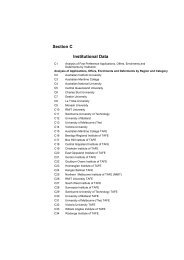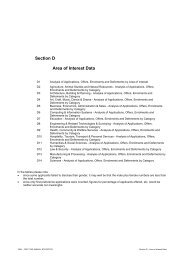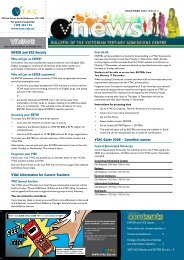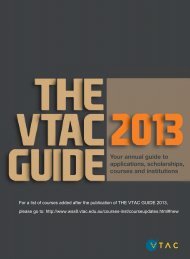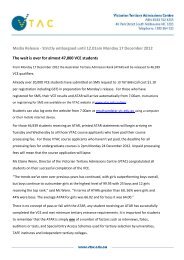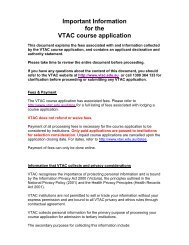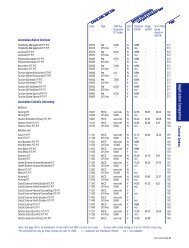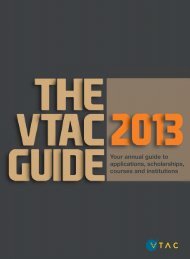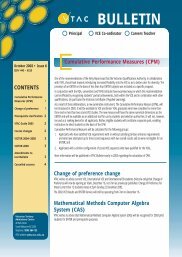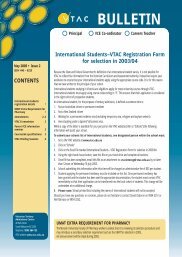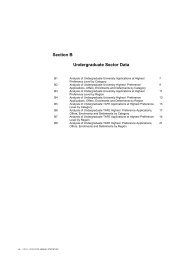VICTER 2015: Victorian Tertiary Entrance Requirements - VTAC
VICTER 2015: Victorian Tertiary Entrance Requirements - VTAC
VICTER 2015: Victorian Tertiary Entrance Requirements - VTAC
You also want an ePaper? Increase the reach of your titles
YUMPU automatically turns print PDFs into web optimized ePapers that Google loves.
Australian <strong>Tertiary</strong> Admission Rank (ATAR)<br />
What is the ATAR?<br />
The ATAR is an overall percentile ranking reflecting a student’s<br />
comparative Year 12 achievement compared to the relevant age<br />
group in a given year. The ATAR allows tertiary institutions to compare<br />
students who have completed different combinations of VCE studies. It<br />
is calculated by <strong>VTAC</strong> solely for use by institutions.<br />
The ATAR is reported as a rank between 0.00 and 99.95 with<br />
increments of 0.05. An ATAR of 75.00 means that a student with that<br />
ATAR has achieved VCE results above 75% of the population of the<br />
relevant age group.<br />
Eligibility for an ATAR<br />
To qualify for an ATAR a student must:<br />
• qualify for the VCE<br />
• achieve study scores in at least four permissible Unit 3 and 4 VCE<br />
studies, including one from the English group.<br />
Who receives an ATAR?<br />
<strong>VTAC</strong> calculates an ATAR for all students who have qualified for an ATAR,<br />
however only those who apply through <strong>VTAC</strong> for tertiary courses and<br />
paid their <strong>VTAC</strong> processing fees receive an ATAR statement.<br />
An ATAR will be calculated by <strong>VTAC</strong> for applicants when they first<br />
qualify for an ATAR. If you undertake further study in a later year and<br />
are awarded at least one study score or complete a non-scored VET<br />
sequence that entitles you to an additional VET increment, a new ATAR<br />
will be calculated. Ranking for courses will be based on the highest<br />
ATAR achieved.<br />
You will receive an official statement containing your ATAR from <strong>VTAC</strong><br />
at the same time that you receive study scores from the VCAA if you<br />
have applied for tertiary entry through <strong>VTAC</strong>.<br />
Calculation of the ATAR<br />
Your ATAR is developed from an aggregate produced by adding your<br />
results for up to six studies as follows:<br />
• the scaled score in one of English, English (EAL), Literature or<br />
English Language<br />
• the three next highest scaled scores permissible (which together<br />
with the English study make the “primary four”)<br />
• 10% of any fifth and sixth permissible scores that are available<br />
(these are called increments).<br />
If you have more than six results, the six permissible results that give<br />
the highest ATAR are used.<br />
Studies used in the calculation of the ATAR may be taken over any<br />
number of years; however the time taken to complete VCE studies may<br />
be taken into account by institutions when considering applicants.<br />
You are then ranked in order of these aggregates—the highest rank<br />
being 99.95 and then decreasing in steps of 0.05. The group of<br />
students with the highest aggregates will be assigned the highest rank<br />
of 99.95. The lowest automatically reported ATAR is 30.00, with ATARs<br />
below 30.00 being reported as ‘less than 30’.<br />
Notional ATARs<br />
Notional ATARs are used to rank applicants who either have<br />
previous <strong>Victorian</strong> Year 12 results (other than VCE results) or<br />
another qualification obtained in Victoria such as the International<br />
Baccalaureate. In the case of previous <strong>Victorian</strong> Year 12 results, a<br />
Notional ATAR is calculated using the same rules as for the ATAR. For<br />
other qualifications, different methods are used whilst still adhering to<br />
the same underlying principles. Further information may be obtained<br />
from <strong>VTAC</strong>.<br />
Only <strong>Victorian</strong> IB students who sit the GAT and are <strong>VTAC</strong> applicants<br />
will be issued with a Notional ATAR statement.<br />
Interstate use of ATARs<br />
<strong>Victorian</strong> VCE applicants applying for tertiary courses in other Australian<br />
states will be considered on the basis of their ATAR.<br />
Scaling study scores for the ATAR<br />
In calculating study scores, the VCAA does not determine any measure<br />
of overall performance in the VCE, but rather the performance of<br />
each student in each individual study. In order to facilitate selection,<br />
institutions require an overall measure of the performance of students<br />
undertaking the VCE in all studies.<br />
Before the scores of different VCE studies can be added together<br />
for the ATAR, they need to be scaled to take account of the different<br />
abilities of the students taking different studies.<br />
The study score is not a score out of 50. It is a ranking or relative<br />
position which shows a student’s performance compared with all<br />
other students who took that study in that year. A student with a study<br />
score of 30 is in the middle of the cohort, or has performed better<br />
than about half of all students. A student with a study score of 40 has<br />
performed better than about 91% of all students who did that study.<br />
What this means is that the middle student in any study will have a<br />
study score of 30, regardless of how strong the other students were in<br />
the study and how difficult it was to achieve the middle ranking. This<br />
does not mean that some studies are inherently more difficult than<br />
others. In fact, most are designed to be of equal difficulty. However, the<br />
stronger the competition, the harder it is to achieve the middle score of<br />
30.<br />
So all study scores are scaled by <strong>VTAC</strong> before they are used to calculate<br />
the ATAR. Scaling adjusts the study scores in each study to take<br />
account of the strength of competition among students taking the<br />
study. The strength of competition in each study is measured by how<br />
well the students in that study performed in their other studies. The<br />
study scores are scaled so that the overall level of scores in that study<br />
matches the scores obtained by the same group of students in all of<br />
their other studies combined.<br />
Once the study scores have been scaled, they are called scaled scores.<br />
It is the scaled scores that are used to calculate the ATAR. VCE studies<br />
are always scaled in the year in which they were undertaken (this may<br />
not necessarily be in the year in which you receive your ATAR).<br />
By using scaled scores, fair comparisons can be made of students’<br />
achievements over all their studies, regardless of the studies they have<br />
taken.<br />
Because of this, students can freely choose studies they like or are<br />
good at without worrying about their ATAR.<br />
This is not always well understood and many students believe that to<br />
achieve their best possible ATAR they need to choose studies that are<br />
scaled up. This is not true and may even work against you. Every year<br />
there are many students who achieve high scaled scores for studies<br />
that have been scaled down, and achieve lower scaled scores for<br />
studies that have been scaled up.<br />
If you choose a study that you are not very good at simply because it<br />
will be scaled up, the study score you receive will be a lot lower than<br />
what you could expect in a study you are good at and that interests you.<br />
6 <strong>VICTER</strong> <strong>2015</strong>




